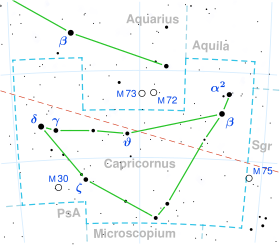Phi Capricorni
| Observation data Epoch J2000.0 Equinox J2000.0 (ICRS) | |
|---|---|
| Constellation | Capricornus |
| Right ascension | 21h 15m 37.89982s[1] |
| Declination | −20° 39′ 06.1032″[1] |
| Apparent magnitude (V) | +5.16[2] |
| Characteristics | |
| Spectral type | K0 II-III[3] |
| B−V color index | +1.15[2] |
| Astrometry | |
| Radial velocity (Rv) | −4.5±0.5[4] km/s |
| Proper motion (μ) | RA: +15.01[1] mas/yr Dec.: −2.07[1] mas/yr |
| Parallax (π) | 5.07 ± 0.25 mas[1] |
| Distance | 640 ± 30 ly (197 ± 10 pc) |
| Absolute magnitude (MV) | −1.16±0.107[5] |
| Details | |
| Mass | 2.63[6] M☉ |
| Luminosity | 447[6] L☉ |
| Surface gravity (log g) | 1.77[5] cgs |
| Temperature | 4,490±25[6] K |
| Metallicity [Fe/H] | −0.15[5] dex |
| Rotational velocity (v sin i) | 3.8[7] km/s |
| Age | 1.24[6] Gyr |
| Other designations | |
| Database references | |
| SIMBAD | data |
Phi Capricorni (φ Cap, φ Capricorni) is a solitary[9] star in the southern constellation of Capricornus. It is visible to the naked eye with an apparent visual magnitude of +5.16.[2] Based upon an annual parallax shift of 5.07 mas as seen from the Earth,[1] the star is located about 640 light years from the Sun, give or take 30 light years.
This is an evolved, orange-hued K-type giant/bright giant star with a stellar classification of K0 II-III[3] It shows an infrared excess, which may be due to leftover material from a mass-loss event.[7] The star has an estimated 2.63 times the mass of the Sun,[6] and radiates 447 times the solar luminosity from its photosphere at an effective temperature of 4,490 K.[6] Phi Capricorni is around 1.24[6] billion years old and is spinning with a projected rotational velocity of 3.8 km/s.[7]
Chinese Name
In Chinese, 十二國 (Shíer Guó), meaning Twelve States, refers to an asterism which is represent twelve ancient states in the Spring and Autumn period and the Warring States period, consisting of φ Capricorni, ι Capricorni, 38 Capricorni, 35 Capricorni, 36 Capricorni, χ Capricorni, θ Capricorni, 30 Capricorni, 33 Capricorni, ζ Capricorni, 19 Capricorni, 26 Capricorni, 27 Capricorni, 20 Capricorni, η Capricorni and 21 Capricorni.[10] Consequently, the Chinese name for φ Capricorni itself represents the state Chu (楚),[11] together with ε Ophiuchi in Right Wall of Heavenly Market Enclosure (asterism).[12][13]
R. H. Allen had opinion that φ Capricorni, together with χ Capricorni, represented the state Wei (魏).[13]
References
- ^ a b c d e f van Leeuwen, F. (2007), "Validation of the new Hipparcos reduction", Astronomy and Astrophysics, 474 (2): 653–664, arXiv:0708.1752, Bibcode:2007A&A...474..653V, doi:10.1051/0004-6361:20078357, S2CID 18759600.
- ^ a b c Corben, P. M.; Stoy, R. H. (1968), "Photoelectric Magnitudes and Colours for Bright Southern Stars", Monthly Notes of the Astronomical Society of Southern Africa, 27: 11, Bibcode:1968MNSSA..27...11C.
- ^ a b Houk, N.; Smith-Moore, M. (1988), Michigan Catalogue of Two-dimensional Spectral Types for the HD Stars, vol. 4, Bibcode:1988mcts.book.....H.
- ^ Gontcharov, G. A. (November 2006), "Pulkovo Compilation of Radial Velocities for 35495 Hipparcos stars in a common system", Astronomy Letters, 32 (11): 759–771, arXiv:1606.08053, Bibcode:2006AstL...32..759G, doi:10.1134/S1063773706110065, S2CID 119231169.
- ^ a b c Park, Sunkyung; et al. (2013), "Wilson-Bappu Effect: Extended to Surface Gravity", The Astronomical Journal, 146 (4): 73, arXiv:1307.0592, Bibcode:2013AJ....146...73P, doi:10.1088/0004-6256/146/4/73, S2CID 119187733.
- ^ a b c d e f g Luck, R. Earle (2015), "Abundances in the Local Region. I. G and K Giants", Astronomical Journal, 150 (3), 88, arXiv:1507.01466, Bibcode:2015AJ....150...88L, doi:10.1088/0004-6256/150/3/88, S2CID 118505114.
- ^ a b c Fekel, Francis C.; Watson, Lyndon C. (November 1998), "A Search for Lithium-Rich Giants among Stars with Infrared Excesses", The Astronomical Journal, 116 (5): 2466–2474, Bibcode:1998AJ....116.2466F, doi:10.1086/300614.
- ^ "phi Cap", SIMBAD, Centre de données astronomiques de Strasbourg, retrieved 2017-05-10.
- ^ Eggleton, P. P.; Tokovinin, A. A. (September 2008), "A catalogue of multiplicity among bright stellar systems", Monthly Notices of the Royal Astronomical Society, 389 (2): 869–879, arXiv:0806.2878, Bibcode:2008MNRAS.389..869E, doi:10.1111/j.1365-2966.2008.13596.x, S2CID 14878976.
- ^ (in Chinese) 中國星座神話, written by 陳久金. Published by 台灣書房出版有限公司, 2005, ISBN 978-986-7332-25-7.
- ^ (in Chinese) AEEA (Activities of Exhibition and Education in Astronomy) 天文教育資訊網 2006 年 7 月 4 日 Archived 2011-05-22 at the Wayback Machine
- ^ (in Chinese) AEEA (Activities of Exhibition and Education in Astronomy) 天文教育資訊網 2006 年 6 月 24 日 Archived 2011-05-22 at the Wayback Machine
- ^ a b Allen, Richard Hinckley (1963), "Capricornus", Star Names, Their Lore and Meaning, Dover, retrieved 2017-05-09.

